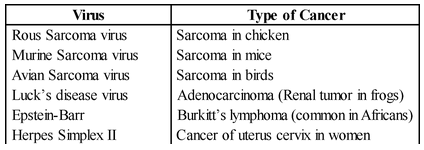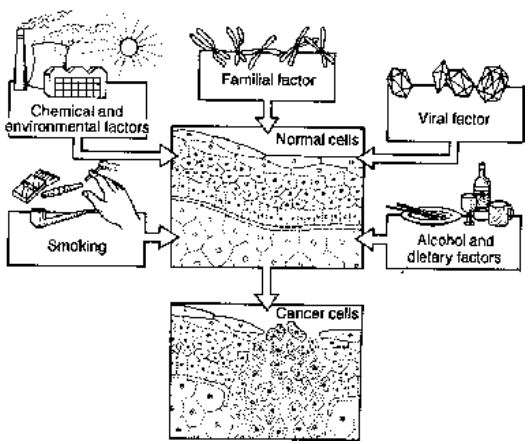
Cancer
Human Health and Diseases of Class 12
Cancer
Abnormal uncontrolled cell division in any part or tissue of the body causing its extra growth, is called Neoplasia or tumour.
Neoplasm defined as the abnormally grown mass of cells.
According to their nature and effects tumour are of two types :- (i) Benign (ii) Malignant (cancer).
Oncology — Study of cancer.
Following are the contrasting features of both types:
Benign tumour Malignant tumour
- Neoplasia remain covered (arrested) - No capsule around this neoplasm within connective tissue capsule
- Not of migratory nature - Of migratory nature (metastatic)
- No harmful effect - Very harmful.
- No anaplasia, (no change in form and - Anaplasia is the main feature chemical nature of cell)
- Cannot turn other tissue neoplastic - This causes neoplasia to other tissue which
- makes their growth unpredictable
- Slow growth and noninvasive - Rapid growth and invasive
- Highly differentiated - Poorly differentiated.
Other features of cancer cells
Cell division is uncontrolled in any part of the body
Generally detected in metastatic (or 2nd stage) stage.
Loss of contact inhibition, do not follows Hay-flick limit and proper cell cycle phases.
Highly complex in nature, no certain cause can be attributed Occurs primarily due to wrong expression of genes, the oncogenes formed from protooncogenes which is responsible for the normal growth and maintenance of all cells.
Common causes
Any agent that induces a cancer is called carcinogenic or oncogenic agent. Radiation, sunlight, UV rays cause Xeroderma pigmentosum, the skin cancer.
Virus also cause cancer


Fig. Different Cancer Causing Factors
Chemicals are carcinogens e.g.
Soot - lung
- Coal tar (3, 4-benzopyrene) - lung, skin
- Cigarette smoke (N-nitrosodimethylene) - lung
- Asbestos and Mustard gas - lung
- Nickel, Chromium compound - lung
- Diethylstilbestrol (DES) - Uterus
- Aflatoxin and Vinyl chloride (VCM) - liver
- Cadmium oxide - prostate gland
- 2-naphthylamine, and 4-aminobiphenyl - Urinary bladder.
Types of Cancer
The name is generally coined by adding suffix ‘oma’ to the type of tissue it affects.
Carcinoma - Epithelial tissue (ectodermal and endodermal origin)
- Sarcoma - Connective tissue (mesodermal origin).
- Leukemia - Blood cancer.
- Lymphoma - Lymphoid tissue
- Teratoma - Ovary, testis.
- Melanoma - Cancer of pigment cells of the skin
- Adenoma - Cancer of glands
- Myoma - Cancer of muscle tissue
- Glioma - Cancer of glial cells of CNS.
Alarm symptoms
Persisting obstruction in gut and change in digestive and bowel process.
Abnormal lump or hard area in breast.
Abnormal bleeding through any natural orifice.
Unexplained loss of body weight.
Persistent sore throat; hoarseness of voice.
Excess bleeding during menstruation.
Therapy
Surgery; Radiation therapy; Chemotherapy Gleevec, a new drug approved in May 2001 for the treatment of Leukemia and also effective in the cancer of lung, stomach and prostate.
A plant Catharanthus (or Vinca rosea) also called as Sadabahar is the source for vincristin and vinblastin. Cytochalasin B is anti-cancerous drug.









